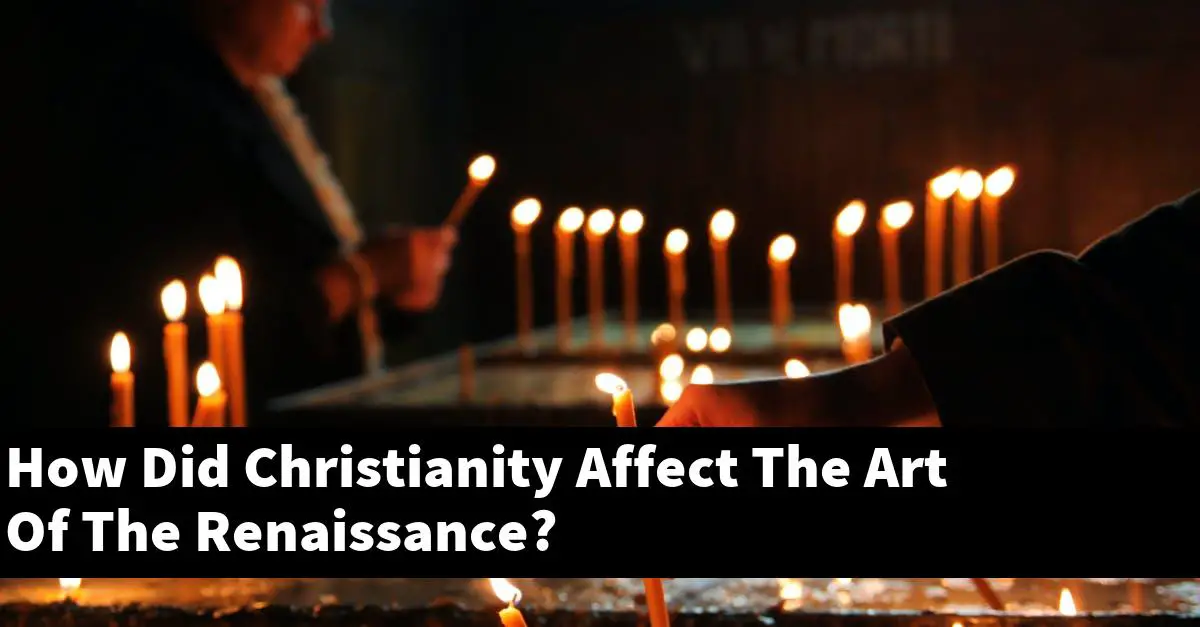The Renaissance was a time of great artistic achievement, and Christianity played a significant role in shaping the art of this period. Christianity had a profound influence on the subjects that Renaissance artists chose to depict, as well as the style and approach that they took.
Christianity also had a significant impact on the patrons of Renaissance art. Many of the most important works of Renaissance art were commissioned by the Church, and so the artists had to take into account the religious beliefs of their patrons.
Overall, Christianity had a profound impact on the art of the Renaissance, shaping both the content and the form of many of the period’s most important works.
How was the Renaissance influenced by Christianity?
The Renaissance was a period of intense cultural and artistic activity in Europe, lasting from the 14th to the 16th centuries. It was characterized by a renewed interest in classical antiquity, a flowering of mathematics and science, and a revival of interest in the humanities.
The Renaissance was influenced by Christianity, in particular by the belief that through faith in Jesus Christ humans could be saved from their sins. This belief led to the development of new modes of thought and expression, including the development of the modern world view.
How did Christianity impact art?
Christianity had a significant impact on art because it provided a framework for artists to create and view art in a new and unique way. Prior to Christianity, art was seen as a way to glorify one’s gods and was used primarily for entertainment purposes.
Christianity, on the other hand, taught that art should be used to glorify God and to communicate His message to the world. This change in perspective led to a rise in religious art, which is typically more spiritual and less flashy than secular art.
Additionally, because Christianity is based on the teachings of Jesus Christ, artists were able to create art that conveyed His message in a more personal way. This increased emphasis on religious art led to the development of more realistic portrayals of characters and scenes from the Bible, as well as the creation of new art genres such as gospel music and stained glass.
How did religion influence Renaissance art?
Religion played a significant role in the development of Renaissance art. The Renaissance was a time of great change and progress in art, which is often attributed to the Renaissance artists’ desire to restore classical art to its former glory.
Religion was a major source of inspiration for Renaissance artists, who used it as a tool to explore their own spiritual beliefs.
One of the most important aspects of Renaissance art was the use of perspective. Artists used perspective to create a sense of depth and space, which was inspired by religious paintings of the time.
The use of perspective was a way to create a more realistic image, and it was used to depict religious scenes and figures in a way that emphasized their importance.
Religion also played a role in the development of Renaissance art as a whole. Renaissance artists used religious imagery to express their own beliefs, and they often used religious themes to create masterpieces.
For example, Michelangelo’s statue of David is often cited as one of the greatest examples of Renaissance art. David is a religious icon, and Michelangelo used his understanding of biblical symbolism to create a masterpiece that is still admired today.
How did the Catholic Church affect the Renaissance?
The Catholic Church had a significant impact on the Renaissance due to its insistence on the use of Latin in religious texts and its support of learning. This led to the development of a more literate society and the rise of intellectual giants such as Leonardo da Vinci and Galileo Galilei.
The Church also helped to fund the development of universities and encouraged the study of the classics.
How did humanism and religion affect Renaissance art?
The Renaissance was a time of great change in Europe, as humans began to explore new ways of thinking and living. This change was largely due to the arrival of humanism, a movement that emphasized the importance of human intellect and creativity.
At the same time, religion began to change as well. This was due to the spread of new doctrines, such as the Protestant Reformation, which questioned the authority of the Catholic Church.
As a result, Renaissance art began to reflect these changes, becoming more expressive and colorful.
How did Christianity influence Roman art?
Christianity had a significant influence on Roman art in the 4th century AD. One of the main ways this influence was manifested was through the use of Christian symbols and motifs in art. This was partly done to show that the artwork was sanctioned by the church, and partly as an expression of Christian values and beliefs.
This trend continued into the 5th century, and many of the most famous Roman sculptures and paintings were created during this period.
How did religion influence art?
Religion influences art in a variety of ways. For example, some religious texts may be used as inspiration for art, or religious art may be used to communicate religious messages to the public.
Additionally, religious art may be used to promote a certain religious belief system.
How did Christianity affect the production of art in the medieval period?
Christianity had a significant impact on the production of art in the medieval period. Christianity taught its followers to see art as a way to express their faith in a way that was accessible to all.
This encouraged artists to create art that was both beautiful and meaningful to the people who saw it. Additionally, the Church played a significant role in funding and promoting art throughout the medieval period.
This helped to create a thriving art scene that was unique to the Christian world.
What is Renaissance in Christianity?
Renaissance is a period in European history that spanned the 14th to the 16th centuries. The Renaissance was a time of great intellectual and artistic productivity, as well as a time of great social and cultural change.
The Renaissance began in Florence, Italy, in the early 1400s, and spread to other parts of Europe over the next several centuries. The Renaissance was a time when people began to rediscover the ancient classics of literature, art, and philosophy, and to develop new methods of thinking and creating.
The Renaissance was also a time of great change in the way people lived their lives. People began to move away from the traditional ways of life that had been in place for centuries, and they began to develop new ways of thinking and living.
The Renaissance was a time of great progress, and it was the beginning of the modern era.
How did Renaissance artists treat religious subjects differently?
The Renaissance was a time of great change and growth in the arts. The Renaissance artists treated religious subjects differently than their predecessors because they were looking to express themselves more freely and creatively.
They believed that art should be used to teach and inspire people, not just to decorate churches. This led to a more realistic and expressive style of painting and sculpture, which was particularly evident in religious paintings.
What is the importance of religion to art in the Middle Ages?
Religion played an important role in the arts during the Middle Ages. Religious themes and motifs were frequent in art, and religious ceremonies and festivals were often depicted in art.
Religious art served as a source of inspiration for artists and helped to shape the artistic traditions of the period.
Conclusion
Christianity had a profound impact on the art of the Renaissance. The Renaissance was a time of great religious turmoil, and many artists used their work to express their religious beliefs.
Christianity also had a significant impact on the development of perspective and other artistic techniques.


